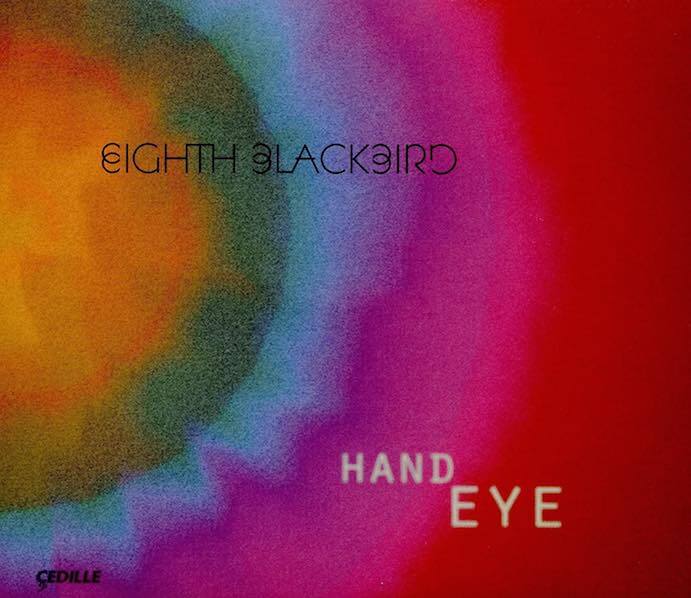Eighth Blackbird is an ensemble of big projects and high concepts and their album Hand Eye on Cedille Records is no exception. Imagined as a continuous, evening-length program by the six composers in the Sleeping Giant collective, it premiered at the Great Lakes Chamber Music Festival in June and was reviewed by Justin Rito on I Care if You Listen. Each piece took inspiration from a different artwork in the Maxine and Stuart Frankel Foundation’s collection. It is with the Sleeping Giant brand of contemporary music that Eighth Blackbird excels: energetic, detailed, and colorful, with a synthesis of many styles and preference for melody.
Inspired by Astrid Bowlby’s dizzying pen-and-ink patterns, Timo Andres’ Checkered Shade begins with motor rhythm in the upper strings of Yvonne Lam’s violin and large shimmering chords in the rest of the ensemble, giving way to a lopsided ostinato on low, muted piano strings. The piece feels a bit long with its many sections and ideas, though it is brilliantly orchestrated with a lushness that belies the size of the ensemble.
Andrew Norman’s charming Mine, Mime, Meme is inspired by rAndom International’s installation Audience, in which motorized mirrors follow visitors around a room, tracking their movement like rapt, flat-faced admirers. Nicholas Photinos’ cello wanders among a field of small reflectors, its slow melody echoing in the other instruments. Their mimetic nature is truly revealed in the suddenly-spiky phrase endings as each instrument struggles to catch the cello in a chromatic tangle. Eventually, the ensemble breaks into two competing factions, a thousand colorful surfaces bursting against a soaring cello.
eighth blackbird (photo credit: Luke Ratray)
Robert Honstein’s three-movement Conduit is based on 640 by 480 by Zigelbaum and Coelho, a modular installation consisting of lighted blocks that copy and paste color patterns to each other. Like musical instruments, these little sculptures are only activated by the touch of a human hand. The first movement, “Touch,” is driven by rapid scales in each instrument, swept upward by a kick drum and woodblock. “Pulse” is a quiet contrast, each voice navigating a line in overlapping polyrhythms, recalling the simple and evocative tintinnabulation process of Arvö Part’s works. A wandering but rhythmic piccolo solo begins “Send,” and the ensemble accumulates along each repeated joyful figure.
Christopher Cerrone’s work South Catalina is the emotional high point of Hand Eye. A plain, almost folk-like fragment repeats throughout, descending but never grounding before it restarts, surrounded by string harmonics and percussionist Matthew Duvall’s crotales which glint like a Pacific sunset (also evoking the rAndom International’s “Swarm” light installation which inspired it).
Ted Hearne’s By-By Huey takes its name from Robert Arneson’s painting of Tyrone “Double R” Robinson, who murdered Black Panther Party co-founder Huey P. Newton in 1989. In this dense and rhythmic work, the piano preparations rattle as if the mantis overlaid on Arneson’s portrait is scuttling across the instrument’s low strings. Pianist Lisa Kaplan attacks the inside mechanisms of the piano, occasionally inserting a bluesy chord, as the ensemble lays thick ropes of dissonance that suddenly snap taut.
Sleep Giant Collective
“I incrementally build a ‘case’ of disparate and self-contained instrumental gestures around a central “object”…I then gradually remove the ‘object,’ leaving only the sonic encasement,” writes Jacob Cooper of Cast, which is based on Leonardo Drew’s paper sculptures of everyday objects, their colorless and fragile forms robbed of quotidian nostalgia. The “cast” is a simple vibraphone arpeggio, unhurried and uninflected. Declamatory chords in the piano re-voice themselves around the keyboard like the slow phantom of a Liszt sonata. Slowly, the other instruments enter: Tim Munro’s flute suffused with breathy sputters, Michael Maccaferri’s clarinet stubbornly pursuing a sustained, quiet note. These scattered intrusions gain frequency, length, and sophistication as the vibraphone fades behind them, the “cast” bearing little resemblance to its original object.
That Eighth Blackbird performs this work as a single suite showcases the unity and strength of Sleeping Giant’s composers, perhaps to a fault: sometimes the techniques feel predictable, the emotional landscape inviting but static. However, the performances are excellent and there’s a lot to uncover in Hand Eye, even in music is so readily accessible at first listen.
Hand Eye @ MCA Chicago from Eighth Blackbird on Vimeo.

